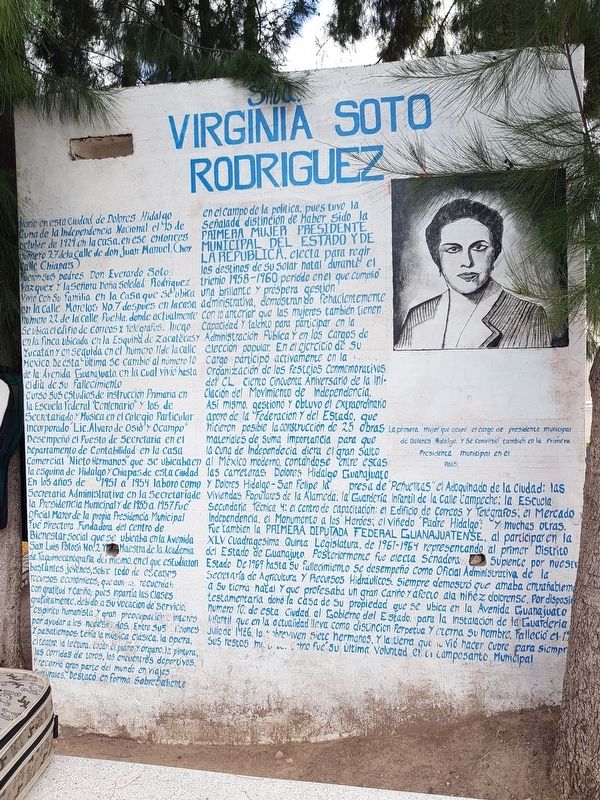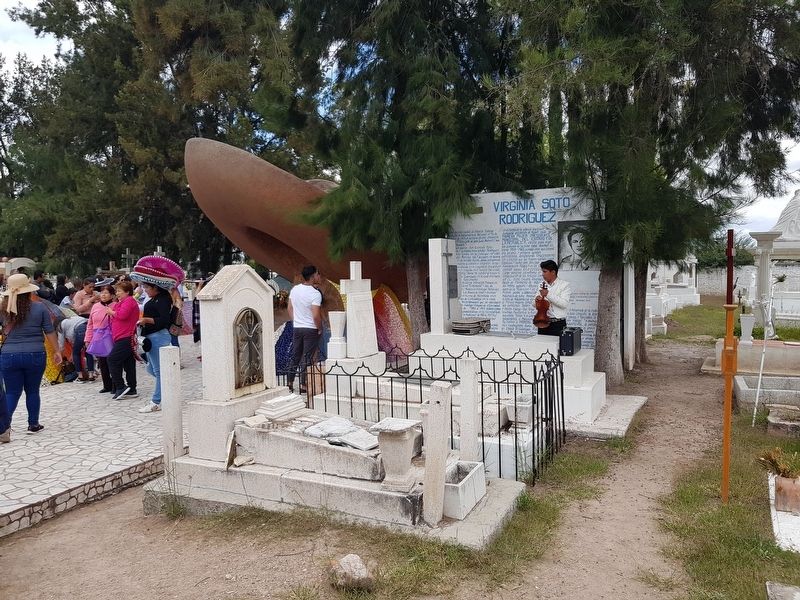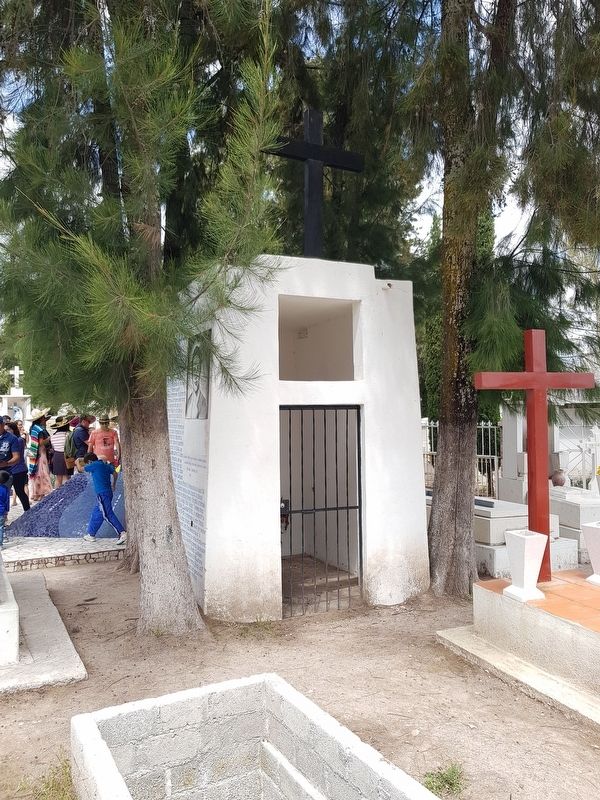Dolores Hidalgo, Guanajuato, Mexico — The Central Highlands (North America)
Virginia Soto Rodríguez
First Woman Municipal President of Mexico
Nacio en esta Ciudad de Dolores Hidalgo Cuna de Independencia Nacional, el 15 de octubre de 1924 en la casa, en ese entonces número 27 de la Calle de Don Juan Manuel (hoy Calle Chiapas). Fueron sus padres Don Everardo Soto Vazquez y la Señora Doña Soledad Rodriguez. Vivió con su familia en la casa que se ubica en la Calle Morelos No. 7 después en la casa número 22 de la Calle Puebla, donde actualmente se ubica el edificio de Correo y Telegrafos. Luego en la finca ubicada en la Esquina de Zacatecas y Yucatán y en seguida en el número 11 de la Calle México. De esta última se cambió al número 10 de la Avenida Guanajuato, en el cual vivió hasta el día de su fallecimiento.
Cursó sus estudios de Instrucción Primaria en la Escuela Federal “Centenario” y los de Secretariado y Música en el Colegio Particular Incorporado “Lic. Alvaro de Osio y Ocampo”. Desempeño el puesto de Secretaria en el Departamento de Contabilidad en la Casa Comercial “Nieto Hermanos” que se ubicaba en la esquina de Hidalgo y Chiapas de esta ciudad. En los años de 1951 a 1954 laboró como Secretaria Administrativa en la Secretaría de la Presidencia Municipal de 1955 a 1957 fue Oficial Mayor de la propia Presidencia Municipal. Fue Directora Fundadora del Centro de Bienestar Social que se ubicaba en la Avenida San Luis Potosi No. 2 y Maestra de la Academia de Taquimecanografia del mismo, en el que estudiaron bastantes jóvenes, sobre todo de escasos recursos económicos, que aun la recuerdan con gratitud y cariño, pues impartía las clases gratuitamente, debido a su vocación de servicio, espíritu humanista y gran preocupación e interés por ayudar a los necesitados. Entres sus aficiones y pasatiempos tenía la música clásica, la opera, el teatro, la lectura, tocar el piano y órgano, la pintura, las corridas de toros, los encuentros deportivos, y recorrió gran parte del mundo en viajes culturales. Destacó en forma sobresaliente en el campo de la política, pues tuvo la señalada distinción de haber sido la Primer Mujer Presidente Municipal del Estado y de la República, electa para regir los destinos de su solar natal durante el trienio 1958-1960 periódo en el que cumplió una brillante y próspera gestión administrativa, demostrando fehacientemente con lo anterior que las mujeres también tienen capacidad y talento para participar en la Administración Pública y en los cargos de elección popular. En el ejercicio de su cargo participó activamente en la organización de los festejos conmemorativos del CL ciento cincuenta Aniversario de la Iniciación del Movimiento de Independencia. Así mismo, gestionó y obtuvo el extraordinario apoyo de la Federación y del Estado, que hicieron posible la construcción de 25 obras materiales de suma importancia para que la Cuna de Independencia diera el gran salto al México moderno, contándose entre estas las carreteras Dolores Hidalgo Guanajuato y Dolores Hidalgo – San Felipe la presa “Peñuelitas” el Adoquinado de la Ciudad: las viviendas populares de la Alameda; la Guardería Infantil de la Calle Campeche; la Escuela Secundaria Técnica 4: el Centro de Capacitación: el Edificio de Correos y Telégrafos; el Mercado Independencia, el Monumento a los Héroes; el Viñedo “Padre Hidalgo”; y muchas otras. Fue también la Primera Diputada Federal Guanajuatense, al participar en la XLV Cuadragesima Quinta Legislatura, de 1961-1964 representando al primer Distrito del Estado de Guanajuato. Posteriormente fue electa Senadora Suplente por nuestra Secretaría de Agricultura y Recursos Hidraulicos. Siempre demostró que amaba entrañablemente testamentaria donó la casa de su propiedad que se ubica en la Avenida Guanajuato número 10 de esta ciudad al Gobierno del Estado, para la instalación de la Guardería Infantil que en la actualidad lleva como distinción perpetua y eterna su nombre, falleció
el 19 de julio de 1986, le sobreviven siete hermanos, y la tierra que la vió nacer cubre para siempre sus restos … como fue su ultima voluntad en el camposanto Municipal.
Virginia Soto Rodríguez
Born in this city of Dolores Hidalgo, the Cradle of National Independence, on October 15, 1924 in the house at Number 27 of Don Juan Manuel Street (now Calle Chiapas). Her parents were Everardo Soto Vázquez and Soledad Rodríguez. She later lived with her family in the house that is located at Calle Morelos No. 7, then later at Number 22 on Calle Puebla, where the Mail and Telegraph building is currently located. Later they moved to the area located at the corner of Zacatecas and Yucatán Streets and immediately after to Number 11 of Calle México. From this last house she finally moved to Number 10 of Guanajuato Avenida, where she lived until the day of her death.
She studied Primary Instruction in the Federal School "Centenario" and then the degrees of Secretary and Music at the Incorporated Private School "Lic. Álvaro de Osio and Ocampo." She held the position of Secretary in the Accounting Department of the "Nieto Hermanos" Commercial House, which was located on the corner of Hidalgo and Chiapas Calles in this city. In the years from 1951 to 1954 she worked as Administrative Secretary in the Secretariat of the Municipal Presidency and then from 1955 to 1957 she was the Senior Officer of the Municipal Presidency itself. She was the Founding Director of the Social Welfare Center located on Avenida San Luis Potosí No. 2 and Teacher of the Academy of Typewriting at the same location, in which many young people studied, especially those of low economic resources, who still remember it with gratitude and love, because she taught many of her classes for free, due to her vocation of service, humanistic spirit and great concern and interest in helping the needy. Among her hobbies she had classical music, opera, theater, reading, playing the piano and organ, painting, attending bullfights, sporting events, and touring much of the world on cultural trips. She excelled in the field of politics, having the distinguished distinction of having been the First Woman Municipal President of the State and the Republic, elected to govern the destinations of her home during the 1958-1960 period in which she fulfilled a brilliant and prosperous administrative management, proving convincingly that women also have the capacity and talent to participate in Public Administration and in positions of popular election. In the exercise of her position she participated actively in the organization of the commemorative celebrations of the 150th anniversary of the Initiation of the Independence Movement. Likewise, she managed and obtained the extraordinary support of the Nation and the State, which made possible the construction of 25 material works of great importance for the Birthplace of Independence to make the great leap to a modern Mexico, including the Dolores Hidalgo - Guanajuato highways and the Dolores Hidalgo - San Felipe Highway, the "Peñuelitas" dam, the paving of the city’s streets, the popular housing projects of the Alameda, the Children’s Nursery of the Calle Campeche, the Number 4 Technical High School, the Training Center, the Post and Telegraph Building, the Independence Market, the Monument to the Heroes; the "Padre Hidalgo" Vineyard and many others. She was also the First Female Federal Representative of Guanajuato, when she participated in the Forty-Fifth Legislature, from 1961-1964, representing the first District of the State of Guanajuato. Subsequently she was elected as Substitute Senator to our Ministry of Agriculture and Hydraulic Resources. He always showed that she dearly loved this city and she showed that through the donation of the house that is located at Avenida Guanajuato 10 of this city to the State Government, for the installation of the Children’s Nursery that currently carries her eternal name and distinction. She died on July 19, 1986. She is survived by seven brothers. The land that saw her birth covers her remains forever here in the Municipal Cemetery ... as were her last wishes expressed in her will and testament.
Topics. This historical marker is listed in these topic lists: Government & Politics • Women. A significant historical date for this entry is July 19, 1986.
Location. 21° 9.4′ N, 100° 56.917′ W. Marker is in Dolores Hidalgo, Guanajuato. Marker can be reached from La Cruz del Padre Razo just west of Trujillo. Touch for map. Marker is in this post office area: Dolores Hidalgo GTO 37800, Mexico. Touch for directions.
Other nearby markers. At least 8 other markers are within walking distance of this marker. José Alfredo Jiménez Mausoleum (within shouting distance of this marker); The Hidalgo House and Museum (approx. 1.3 kilometers away); National Independence Museum (approx. 1.4 kilometers away); Casa de Visitas (approx. 1.4 kilometers away); Church of the Tercera Orden (approx. 1.4 kilometers away); Unknown Insurgent Monument (approx. 1.4 kilometers away); The Route of the Insurgents (approx. 1.5 kilometers away); Hidalgo Memorial and Independence Garden (approx. 1.5 kilometers away). Touch for a list and map of all markers in Dolores Hidalgo.
Regarding Virginia Soto Rodríguez. The grave of Virginia Soto Rodríguez, the first woman to fulfill a role similar to that of 'county administrator' (Presidenta Municipal) in Mexican history (1958-1960) is just east of the grave of José Alfredo Jiménez, the famed singer and author of ranchera music.
Credits. This page was last revised on October 10, 2018. It was originally submitted on October 10, 2018, by J. Makali Bruton of Accra, Ghana. This page has been viewed 781 times since then and 82 times this year. Photos: 1, 2, 3. submitted on October 10, 2018, by J. Makali Bruton of Accra, Ghana.


